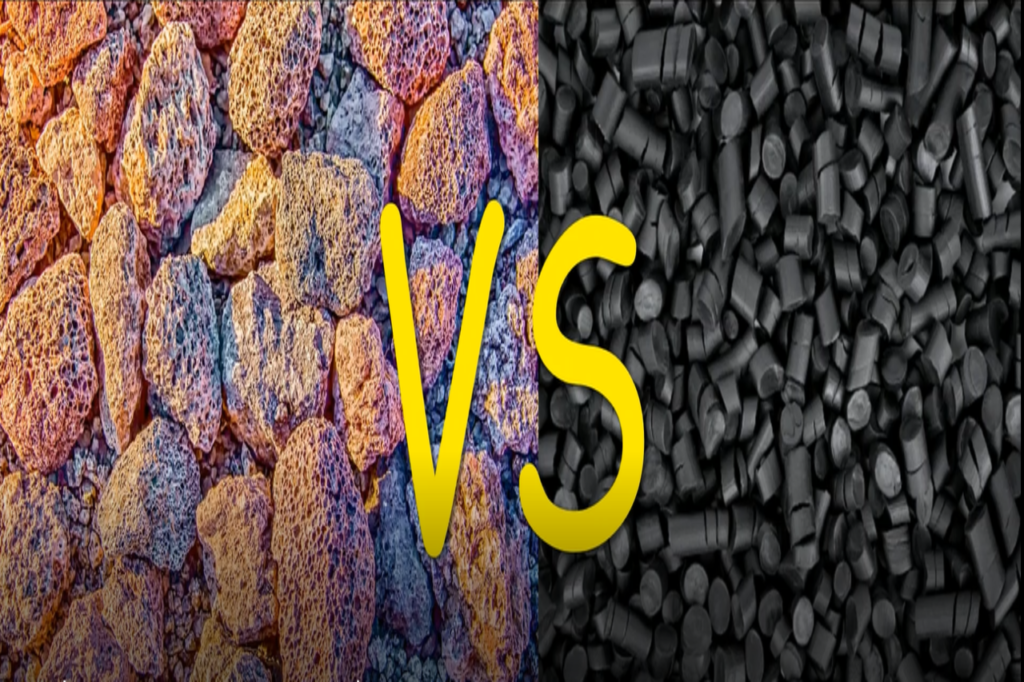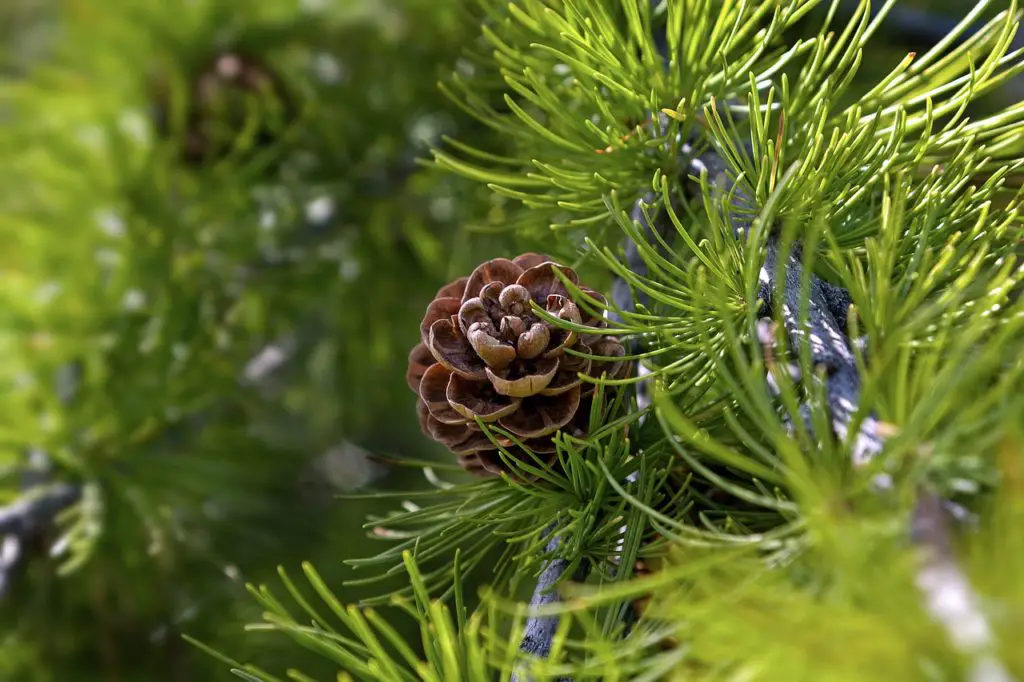Lava rock for landscaping has exploded in popularity in recent years. Apart from how lava rocks make your yard look cool, various benefits come with using them.
They blend well with different landscaping methods while providing similar benefits as rubber mulch. Lava rocks may not break down and nourish plants, but they last long.
In addition, they’re light in weight compared to other stones.
So, between lava rock and rubber mulch, which one is right for you?
Your choice between the two depends on your desired outcome. Lava rock and rubber mulch are non-organic mulches that add a clean landscaped look to your yard. The difference is that rubber mulch is manufactured from recycled tyres, while lava rock comes from volcanic deposits.
Let us look at the different aspects of lava rock and rubber mulch.
Lava Rock vs. Rubber Mulch
Mulching is a weapon used by gardeners against soil moisture loss and weeds. Hence, some gardeners prefer inorganic or synthetic mulches like rubber mulch or lava rock. Although they both have strong advantages in the garden, they also have distinct disadvantages.
Firstly…
What is Lava Rock?
Lava rocks fall in the category of igneous rocks, and they form from erupted lava when it cools down. They have air bubbles that pop as the lava dries and are porous. That explains their lightweight and bubble-shaped holes.
Additionally, lava rocks have three colors available; gray, black, and reddish-brown. The cooling process and the minerals present in the rocks determine their color. For example, the reddish-brown color appears when iron oxidizes as the lava cools down.
What is Rubber Mulch?
Rubber mulch is shredded or in nugget form from recycled chunks of tyres cut into smaller pieces. The mulch offers your garden soil the best insulation from heat. Additionally, the mulch keeps the soil moist while preventing the growth of weeds.
Rubber mulch may not be toxic, but there are arguments that it releases some chemicals into the water, harming wildlife. Accordingly, it would be best not to use rubber mulch near water bodies.
The greatest advantage of rubber mulch is its springy texture. Therefore you can sit comfortably, lay on it, or even kneel. Hence, it’s suitable for horse arenas, paths, and playgrounds.
Ingredients of Lava Rock
There are two main categories of lava rock; mafic rocks and felsic rocks. The difference is in their composition. Mafic rocks comprise magnesium and iron, whereas felsic rocks comprise aluminum and silicone minerals.
Hence, lava rocks fall under the basalts classification because of these chemical compositions. Additionally, they are rich in calcium. Other minerals present in the lava rocks are amphibole, mica, biotite, pyroxene, quartz, olivine, hornblende, feldspar, plagioclase, pyroxene, and magnetite.
Advantages of Lava Rock
- Available in Different Colors: Though not everyone loves using lava rock, it’s a popular option for landscapers because of the different color options available.
- Low Maintenance: Lava rock requires little to no maintenance because, unlike organic mulch, it doesn’t decompose or disintegrate.
- Weed Suppressor: When you add a fabric weed barrier under your layer of lava rock, you effectively hinder weed growth for a long time.
- Soil Protection: When you use lava rocks in mulching, you slow down evaporation and prevent soil erosion.
- Porous: Its porosity allows better drainage. Hence, water doesn’t collect around the lava rock, which prevents fungal growth, keeping your yard healthy.
- Lightweight: Lava rock has air pockets which make it lightweight. Therefore, it doesn’t compress or sink into the soil.
Disadvantages of Lava Rock
- Expensive to Replace: Once you’ve laid the lava rock in your yard, taking it out and replacing it with different mulch is costly. Not only money-wise but also in terms of effort and time.
- Sinks into Soil When Stepped On: If you’ve used lava rock as mulch, the chances of them sinking is high.
- Possibly Hazardous: You need to be extra careful when mowing your lawn. The machine may pelt a rock which could hit the mover, or your exposed body, causing deep cuts.
- Too Light: While being lightweight has its advantages, it also comes with disadvantages. Lava rocks can potentially fly away if there’s a storm.
Is Lava Rock Toxic?
Lava rocks aren’t created equally. Some types of lava rock may contain a lot of iron or other metals that could be toxic. For the most part, though, the lava rock you buy from landscaping houses is safer after rinsing. But, if you have any concerns, soak them in a bucket of water and do a test.
That said, these rocks are actively harmful to dogs. The sharp edges can injure the dog’s paws. Also, because some dogs, for whatever reason, love to eat rocks, the sharp lava rocks can cause them harm.
Is Lava Rock Better Than Rubber Mulch?
Gardeners looking for a permanent solution for their mulching have come to understand the advantages of using lava rocks. Because of their porous and rough nature, they quickly absorb and retain both heat and moisture.
We appreciate these aspects for two reasons:
The lava rocks block moist soil from the sun and retain extra water. Two, the stones retain warmth from the sun during the daytime and redistribute it in the soil during colder evenings. Thus, this helps maintain consistent plant and soil temperatures.
One distinct benefit of lava rocks over organic mulch is that they don’t decompose. Therefore, you don’t need to replace them often.
We recommend that you place the stones 1 inch below the surface of the ground, or you can use an edging material to stop them from displacing, especially in areas where there’s heavy foot traffic.
How Do You Maintain Lava Rock?
Let’s dive into some of the easiest ways to keep your lava rocks looking their best at all times:
Cleaning Mold
You need to keep an eye on mold growth on the lava rocks. You can clean mold by increasing sunlight exposure to the rocks by removing obstacles creating shadows, promoting drainage, and applying a fungicide.
Cleaning Moss
The best way to get rid of moss from the lava rocks is by using a chemical suitable for controlling moss. So, when you’re purchasing one, check out ingredients such as ferrous ammonium sulfate, iron sulfate, and copper sulfate.
Cleaning Algae
To clean off algae from the lava rocks completely, mix a 1:1 ratio of water and bleach in a spray bottle. Spray on the lava rocks liberally, but keep the mixture away from nearby vegetation. If the spray gets to the nearby plants, use water to rinse the foliage, and sprinkle water on the soil to remove any remaining bleach.
Keeping Lava Rocks Clean
Here are some tips that’ll help you keep the lava rocks looking their best:
- Spray water on the rocks periodically to remove dirt and dust.
- Use a leaf blower or anything similar to remove debris and fallen leaves from the rock bed.
- Pull off weeds as soon as you spot them. It promotes better airflow and sunlight.
Are Lava Rocks Good For Landscaping?
Lava rocks are a great resource for landscaping. They look great, retain moisture, keep bugs and weeds away, and have a long life.
Lava rocks absorb heat during the day and release it during nighttime. In addition, they slow evaporation from the soil. When installed with a fabric weed barrier underneath, they create an effective weed suppressant.
How Deep Should Lava Rocks Be For Landscaping?
For sufficient ground cover, plan to lay the rocks 2-3 inches deep. Each cubic foot of lava rock covers a plot of 6 sq ft with a 2-inch layer of lava rocks.
Disadvantages of Landscaping With Lava Rocks
There are problems associated with landscaping using lava rocks:
- Don’t Decompose: At first, the failure to decompose may seem like an advantage, but in the long run, the lava rock doesn’t add any nutrients to the soil, as organic mulches do.
- Reflects Light and Absorbs Heat: The dark lava rock colors absorb heat, raising the soil temperatures. Likewise, the lighter-colored lava rocks reflect light, causing heat radiation away from the mulch and plants. Yet, some plants can’t tolerate warm soil.
FAQs
Is Rubber Mulch Cheaper Than Lava Rock?
No, rubber mulch is more expensive than lava rock. You can source rocks from anywhere, and they cost much less than rubber mulch. Both options stay in place and don’t need to be heavily spread across landscaping or garden soil.
Simply put, both options are low-maintenance alternatives to organic mulching options.
Do Lava Rocks Hold Moisture?
Lava rocks are porous and rough. So, lava rocks absorb and retain heat and moisture.
How Long Do Lava Rocks Last?
When used traditionally, lava rocks last up to 2 years before requiring a replacement. The more you move the lava rocks around, the more they bang against each other, shortening their lives.
Also, wetting lava rocks without drying causes them to burst or crack. Consequently, this reduces their lifespan.
Final Thoughts
When it comes to lava rocks and rubber mulch, it depends on your expectation of the final outcome.
Lava rock and rubber mulch are a great addition to your landscaping needs. They offer dual functionality for your yard and garden landscaping.
Create beautiful yard and landscaping designs with these timeless mulching options.


